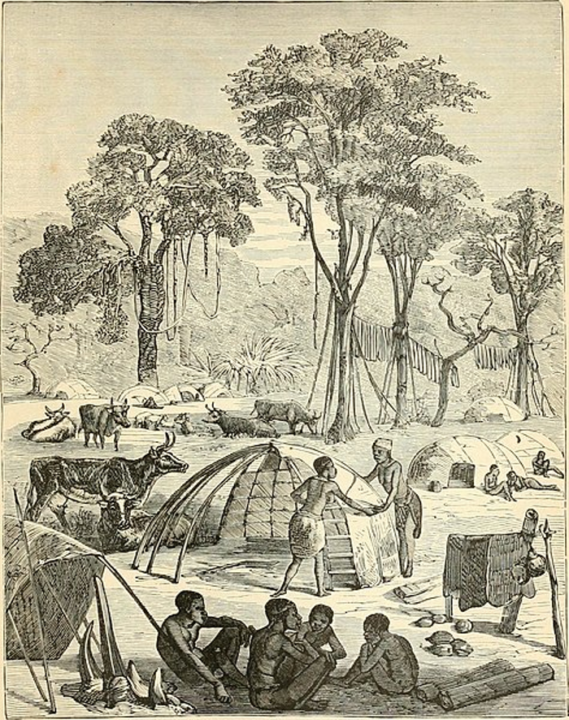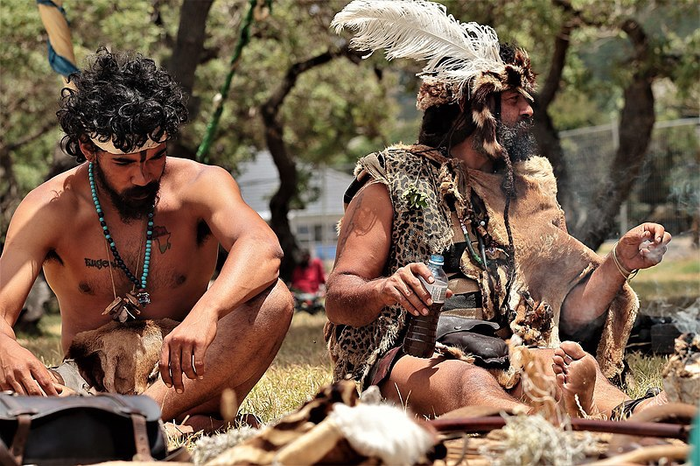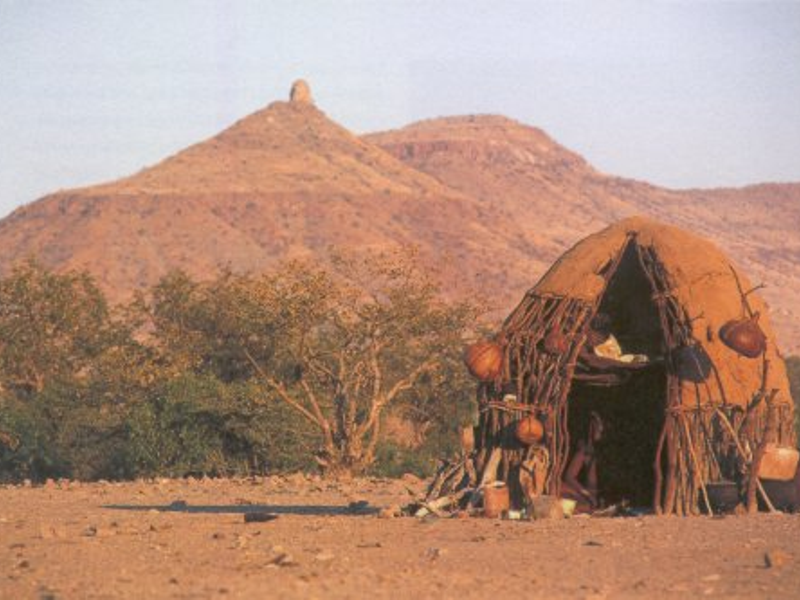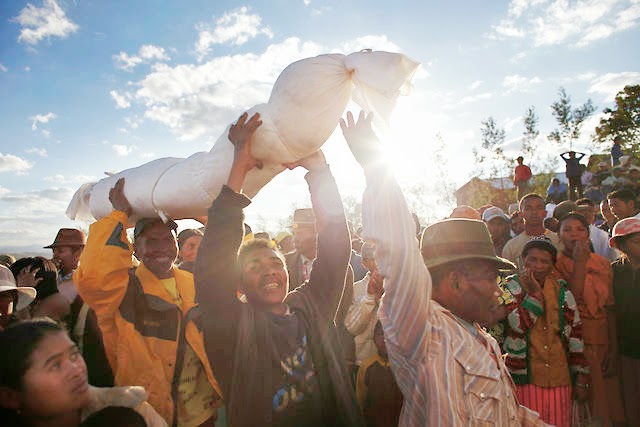Image: Khoikhoi hut. Source: khoisan.org
Long before the first settlers arrived on South African shores, various groups of people spread out sparsely across the land. They were the largest group of humans on earth: the Khoisan, a tribe of skilled hunter-gatherers and nomadic farmers who lived off the land. The San and Khoikhoi people from South Africa are considered to be one of the oldest cultures in the world.
The name Khoisan is a blend of Khoikhoi and San, two groups who share similar cultures and languages. They were, however, two distinct cultural groups. The former chose the name Khoikhoi to show pride in their past and culture and to distinguish themselves from other groups such as the San (SoaQua or SonQua). These were smaller groups of hunter/gatherers who lived off the veld and had no cattle. The Khoikhoi, on the other hand, were nomadic herders who owned vast herds of cattle and sheep and lived in large groups. Khoikhoi means “men of men” or “people of people,” while Khoisan refers to the linguistic and genetic heritage of the Khoikhoi and San people.
The Khoikhoi, also known as the Khoi, Khoekhoe, or Khoekhoen people, are said to be one of the oldest indigenous groups in Southern Africa. This ancient ethnic group has a long and fascinating history that deserves recognition.
The arrival of Khoikhoi
According to South African History Online, the Khoikhoi were the first native people to come into contact with the Dutch settlers in the mid-17th century. The arrival of European settlers had a devastating impact on the Khoikhoi as they were dispossessed of their lands. Not only were their lands taken, but they were also enslaved and persecuted, causing their numbers to decrease.
Following the European settlements, Khoikhoi groups settled in various regions: the Nama people (the largest group of Khoikhoi) occupied modern-day Central Namibia and northeastern Cape; the Gonaqua people in Eastern Cape; the nomadic Korana people settled along the Orange River initially called the Gariep River. But the largest concentration of Khoikhoi, numbering in the tens of thousands inhabited the well-watered pasture lands of the south-western Cape. These ‘Cape’ Khoikhoi were the first African population to face the brunt of European settlement.
European settlers called them ‘Hottentots’ because of the sound of their language, which they found difficult. One of the words that the Khoikhoi used when they danced sounded like “Hottentots”, and that’s how the name came about. However, this term is now widely considered derogatory or offensive.

Image: 1878 depiction of Khoikhoi settlement. Source: Wikimedia Commons
Culture and traditions of Khoikhoi
Khoikhoi culture is characterized by a strong connection to nature, spirituality, and a deep respect for their elders. Understanding and respecting this is essential for acknowledging the diversity and richness of Africa’s indigenous cultures. Some key aspects of their culture and traditions include:
Khoikhoi language: They consist of various subgroups and clans. Consequently, their languages exhibit regional variations and dialects. They are famous for their use of click consonants and complex vowel systems. Cultural aspects such as rituals, songs, and oral traditions are deeply intertwined with their languages.
Spirituality and beliefs: Some believe in a supreme being and ancestor worship. This supreme being, Tsui-//goab, was sometimes seen as the founding ancestor of the Khoikhoi. The deity presides over daily life and controls elements of the environment. This god is worshiped through rituals or small sacrifices. A second, Gaunab, was seen as an evil deity who brings illness and misfortune to earth. Another major figure is Haitsi-aibib, a folk hero and magician of great repute who could change his form. Haitsi-aibib died many times in different places but could come to life again in different forms. His ‘graves’ were seen as good luck for passers-by to add to the piles of stones already there, or to leave branches, pieces of their clothing, or skins.
According to Khoisan.org, many Khoisan people attach special significance to the moon. For many of them, the sun and the moon were gods or aspects of a supreme deity. The new and full moons were important times for rainmaking rites and dancing, and it seems that the moon was viewed as the physical manifestation of a supreme being associated with heaven, earth, and especially rain.

Image: Khoikhoi chief practicing traditional medicine. Source: Wikimedia Commons
Arts and crafts: The Khoikhoi are known for their intricate beadwork, carvings, rock engravings, and other artistic expressions. These art forms often carry symbolic meanings and are integral to their cultural identity. They are known for making clothing, bags, and blankets from animal skins and pottery with pointed bases and handles that are strapped easily to the backs of oxen or their shelters. Another thing they were also very skilled at was making weapons. They made spears with hardened points of iron that they gained from trading with neighboring tribes or European settlers.
Cuisine: The Khoikhoi cuisine is deeply intertwined with nature as they have a principle of using what the land provides. They were mainly hunters and gatherers therefore they ate whatever edible they found on the way. they had a diet that included the meat and milk of their livestock, as well as indigenous plants.
Their mastery of open-fire cooking helped them skillfully roast, grill, and smoke their food. The crackling of the fire and the scent of sizzling meats are integral parts of the Khoikhoi culinary experience.

An early 19th century depiction of the Khoikhoi people. Source: Public Domain
Clothing and Adornments: The Khoikhoi garments are vibrant expressions of culture, heritage, and identity. They are known for their distinctive clothing, which often includes animal skins. Their garments are often crafted from locally sourced materials like animal hides, plant fibers, and natural dyes, showcasing their deep connection to their environment.
Adornments like beads, shells, and feathers are used for decoration. Each bead color and design holds meaning, from celebrating fertility to symbolizing the stages of life. Metal bracelets and anklets are crafted from materials like copper and brass, and they carry spiritual significance. Cowrie shells are prized adornments, which are believed to bring protection and prosperity.
Remarkable skills and knowledge of Khoikhoi people
Many believe they have some of the most incredible knowledge and insights into wild animals and the environment that they inhabit. Their ability to extract nutrients from seemingly inconspicuous plants and survive in generally arid environments is incredible. With their wide knowledge of the medicinal values of plants, they can use natural items to cure hundreds of ailments without modern medicine.
On the hunting side, they had an incredible ability to tune into their surroundings – to track animals across the land and take down wild game with a small poison-tipped arrow.
The decline of Khoikhoi culture
Today, the Khoikhoi people are a minority group in South Africa, with most living in the Northern and Western Cape provinces. Many Khoikhoi are struggling to maintain their traditional way of existence due to centuries of marginalization and discrimination. The Khoikhoi people can no longer hunt as they once did due to the laws in countries where they once lived which prevent them from doing so.
We may well be witnessing the death of their hunter-gatherer lifestyle as some have started to transition into more modern lifestyles, and have shifted to agriculture and herding.
Also, the vibrant languages, in which clicks are used like consonants, are disappearing fast. Traditional music and singing are no longer as prevalent, and the art of making weapons, traditional jewelry, and clothing is getting diluted by modern Western cultures.
However, efforts are reportedly being made to revive and preserve Khoikhoi culture, language, and traditions and to assert their rights as a distinct and marginalized group within South Africa.





